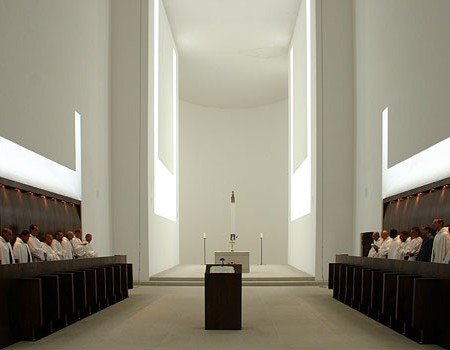 Halifax, UK, 1949
Halifax, UK, 1949John Pawson's distinctive approach to modern architecture has attracted international attention. His work has been built in Spain, Japan and America as well as in Britain. His designs explore fundamentals - space, light and materials - and avoid stylistic mannerisms.
Educated at Eton, Pawson worked in his family's Yorkshire textile mill before spending four years teaching in Japan. He returned to study at the Architectural Association in London, setting up his own practice in 1981.
His architectural career to date has spanned a wide variety of projects, ranging in scale from a compact apartment for the writer Bruce Chatwin, to Calvin Klein's flagship store in Manhattan and airport lounges for Cathay Pacific in Hong Kong. Work in progress includes commissions to design a number of private houses around the world and a new Paris store and private Manhattan apartment for Calvin Klein.
In 1999 John Pawson was commissioned by Cistercian monks to design a new monastery for a site in Bohemia. The scheme combines elements retained from the original baroque complex with entirely new architecture.
While some of the vocabulary is without literal precedent, the design remains true to the spirit of St Bernard's twelfth century architectural blueprint for the Order, with its emphasis on the quality of light and proportion, on simple, pared down elevations and detailing.
The Hotel Puerta América project brings together a team of collaborators which includes Jean Nouvel, Marc Newson, Zaha Hadid, Norman Foster, Christian Liaigre, David Chipperfield, Kathryn Findlay, Jason Bruges, Arata Isozaki, Jonnie Bell, Harriet Bourne, Ron Arad, Plasma Studio, Araki, Richard Gluckman, Teresa Sapey, Vittorio & Luchino, Felipe Saes de Gordoa, Javier Mariscal, Fernando Salas and Arnold Chan.
Ascending the entry ramp, guests pass from the sensory confusion of Madrid into the curved cloister-like space of the Pawson lobby. Light bathes walls and water washes over stone. Here is territory which deals graciously with the rituals of arrival and departure, but which has a strong sense of place, balancing a desire for theatre with the need to feel comfortable.





No comments:
Post a Comment